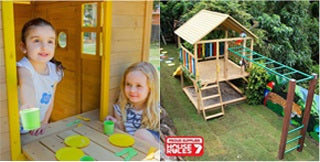The Blog
Plastic vs Wooden Cubby Houses, which one should you choose?

It can seem like there are endless options for cubby houses these days, with different sizes, features and materials to choose from. But one thing that will really help narrow down the choice is deciding on whether you want a plastic or a wooden cubby house. This can be a significant difference, as it affects the types of activities you can do, as well as durability and weather-resistance.
We're here to break down these two choices and give you everything you need to know to make the best decision for your family.
Durability
Wooden Cubby Houses

Wooden cubby houses are highly durable when constructed from quality materials like cedar or pine. Proper treatment, such as regular sealing and painting, is essential to protect against moisture, rot and insect damage. With the right care, a wooden cubby house can endure for many years and even be passed down through generations. The natural sturdiness of wood, combined with routine maintenance, ensures a resilient and reliable playhouse that stands up to active use.
Plastic Cubby Houses

Plastic cubby houses are known for their exceptional durability and low maintenance. Constructed from high-quality, non-toxic plastic, they can handle various weather conditions without rotting or fading. Their main advantage is that they're lightweight and designed to withstand active play, making them a practical choice for busy households. Unlike wood, plastic doesn't require regular treatments or sealing, reducing ongoing maintenance efforts. This resilience makes them an ideal option for families seeking a hassle-free, long-lasting play structure.
Safety Considerations
Safety Features of Wooden Cubby Houses

Look for smooth, rounded edges and well-finished surfaces to minimise the risk of splinters or cuts. We recommend timber that undergoes high-temperature treatment, which is a natural, chemical-free process that enhances the durability and stability of the wood.
Regular maintenance is crucial to check for any structural issues, such as weakened joints or sharp edges. Using non-toxic paints and finishes is also essential for safety. Proper installation and periodic inspections help maintain a safe and enjoyable play space for children.
Safety Features of Plastic Cubby Houses
Plastic cubby houses are designed with several built-in safety features. They often have smooth, rounded edges and non-toxic materials to prevent injuries from sharp corners or harmful substances. Without the risk of splinters or rust, there's a lower risk of cuts and tripping hazards, while their sturdy construction helps prevent tipping or collapsing.
They're also UV-protected to prevent sun damage, ensuring that the material remains intact and safe for children to play in over time.
Maintenance
Maintenance Tips for Wooden Cubby Houses
Start by cleaning the surface with a mild detergent and water to remove dirt and grime. Inspect the wood for signs of wear, such as cracks or splinters, and address them right away. Reapply wood sealant or paint annually to protect against moisture and UV damage. Check for and tighten any loose screws or bolts to maintain structural integrity. Seasonal treatments can prevent rot and insect infestations. For detailed maintenance tips, see this guide.
Maintenance Tips for Plastic Cubby Houses

Plastic cubby houses are relatively low maintenance but still benefit from regular care. Clean the cubby house with mild soap and water to remove dirt and debris, using a soft brush for any stubborn areas. Inspect for cracks or damage and address any issues to ensure safety. To protect against harsh weather, especially in winter, consider covering the cubby house or storing it in a sheltered location when not in use. Check for any accumulated debris in gutters or crevices and remove it to prevent water buildup. For more tips on protecting your play equipment, refer to this article.
Personal Preferences
Wooden cubby houses offer a classic, timeless look that can blend seamlessly with natural outdoor settings. They can be painted or decorated to match your yard's theme and can be customised with unique features.
If you're after a fun DIY project with the family, you may prefer wooden cubby houses for their flexibility in design and the satisfaction of a custom-built project. Building or personalising a wooden cubby house allows for creativity and can be a rewarding experience.
On the other hand, plastic cubby houses come in a variety of bright colours and playful designs, making them appealing for those seeking a more modern or whimsical look. They require less maintenance and are often easier to assemble, which can be a significant advantage for busy families.

Other Considerations
Think about where you plan to place the cubby house. Wooden cubby houses often blend well with gardens and wooded areas, providing a rustic charm. However, they may require more protection from the elements. Plastic cubby houses, being weather-resistant, are better suited for areas with high moisture or extreme weather conditions.
Next, consider the size of the cubby house relative to your space and the number of children who will use it. Be sure to measure your available space and check the dimensions of the cubby house before purchasing.
If a traditional cubby house doesn't fit your needs, consider alternatives like playground structures that combine multiple play features or climbing frames for a more tactile option.
Taking these factors into account will help you choose the best cubby house or play structure for your family's needs and space.
Conclusion

Choosing between a plastic and wooden cubby house ultimately depends on your family's needs. Wooden cubby houses offer a classic, customisable look with durability but require more maintenance. Plastic cubby houses are low-maintenance, weather-resistant and come in vibrant designs, making them ideal for busy households.
Both types can provide years of enjoyment and imaginative play for your children. Evaluate what matters most to you and select the cubby house that best fits your family's lifestyle.














 Shop now, Pay Later
Shop now, Pay Later








